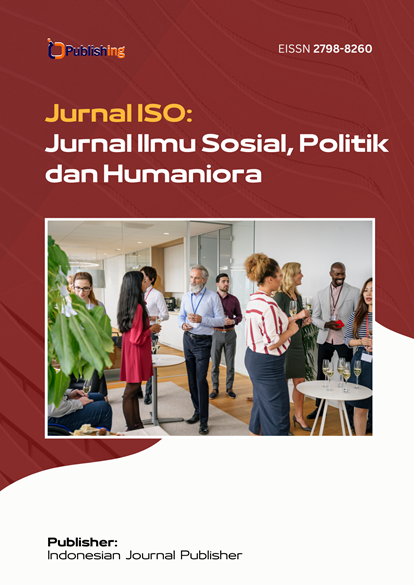Benefits and Effectiveness of the KIP Lecture Program for Recipient Students in Accessing Education at Higher Education
DOI:
https://doi.org/10.53697/iso.v4i2.1932Keywords:
Social Security, KIP-College, Students.Abstract
KIP-College is one of the Social Security programs that serves to help students who want to enter college by providing academic assistance. This program meets the living needs of students, especially for those who have a poor economic background or lack of resources to enter college. The purpose of the KIP-Kuliah program is to address the problem of poverty in the community by providing assistance to underprivileged students to attend college, meet their living needs during college, and prosper from educational and economic deprivation. To carry out this KIP-College program, a qualitative approach is used, which includes the process of observation, interviews, and documentation sessions as concrete evidence. This shows that although the KIP-College program is not well-targeted, it has met the needs of educationally and financially disadvantaged students to attend university.
References
Ahmad Amin, R. N. (2022). KEBIJAKAN KARTU INDONESIA PINTAR UNTUK MEMERDEKAKAN MAHASISWA KURANG MAMPU. Journal of Administration and Educational Management.
Arie Surya Gutama, M. F. (2021). IMPLEMENTASI PROGRAM KARTU INDONESIA PINTAR (KIP) BERDASARKAN BASIS NILAI KEADILAN DALAM KEBIJAKAN SOSIAL. Jurnal Penelitian dan Pengabdian Kepada Masyarakat.
Difa Puspa Dalla, H. K. (2023). Ketimpangan Akses Beasiswa dan Pengaruhnya Terhadap Keberlangsungan Studi Mahasiswa. Jurnal Penelitian Pendidikan dan Pembelajaran, 52-59.
Fauzi, S. (2024). Lembaga Pemberdayaan Masyarakat (LPM): Membangun Komunitas yang Mandiri. kalimantan selatan: Kecamatan Anjirmuara Kabupaten Barito Kuala.
Handayani, K. D. (2023). Potret Beban Pendidikan Siswa dan Orangtua dalam Menghadapi Kebijakan Penerimaan Peserta Didik Baru Zonasi. Pedagogi.
Mangala, B. M. (2022). Masalah-masalah Sosial, Kebudayaan dan Masyarakat. Manado: UNIVERSITAS SAM RATULANGI.
Maya, s. i. (2019). Implementasi Program Indonesia Pintar (PIP). Jurnal Cendikiawan Ilmiah PLS.
Prinada, Y. (2022). Pengertian Masalah Sosial Menurut Soerjono Soekanto & Penyebabnya. Jakarta: Tirto.id.
Rohaeni, N. E. (2018). Implementasi Kebijakan Program Indonesia Pintar ( PIP ) Melalui Kartu Indonesia Pintar ( KIP ) dalam Upaya Pemerataan Pendidikan. . Journal of Education Management and Administration Review, 2(1).
Saâ, H. (2018). Manajemen mutu pendidikan dalam meningkatkan sumber daya manusia. Jurnal Pendidikan Guru Madrasah Ibtidaiyah, 183-204.
Andrejevic, M. (2020). Facial recognition technology in schools: critical questions and concerns. Learning, Media and Technology, 45(2), 115–128. https://doi.org/10.1080/17439884.2020.1686014
Barros, V. (2014). Climate change 2014 impacts, adaptation, and vulnerability Part B: Regional aspects: Working group ii contribution to the fifth assessment report of the intergovernmental panel on climate change. Climate Change 2014: Impacts, Adaptation and Vulnerability: Part B: Regional Aspects: Working Group II Contribution to the Fifth Assessment Report of the Intergovernmental Panel on Climate Change, 1–1820. https://doi.org/10.1017/CBO9781107415386
Belsky, J. (2015). Maternal, infant, and social-contextual determinants of attachment security. Clinical Implications of Attachment, 41–94. https://doi.org/10.4324/9781315825526
Goel, S. (2017). Got phished? Internet security and human vulnerability. Journal of the Association for Information Systems, 18(1), 22–44. https://doi.org/10.17705/1jais.00447
Kelley, T. R. (2016). A conceptual framework for integrated STEM education. International Journal of STEM Education, 3(1). https://doi.org/10.1186/s40594-016-0046-z
Nazmi, A. (2019). A systematic review of food insecurity among US students in higher education. Journal of Hunger and Environmental Nutrition, 14(5), 725–740. https://doi.org/10.1080/19320248.2018.1484316
Owens, M. R. (2020). Prevalence and social determinants of food insecurity among college students during the COVID-19 pandemic. Nutrients, 12(9), 1–17. https://doi.org/10.3390/nu12092515
Saladino, V. (2020). The Psychological and Social Impact of Covid-19: New Perspectives of Well-Being. Frontiers in Psychology, 11. https://doi.org/10.3389/fpsyg.2020.577684
Schiff, D. (2021). Out of the laboratory and into the classroom: the future of artificial intelligence in education. AI and Society, 36(1), 331–348. https://doi.org/10.1007/s00146-020-01033-8
Wang, C. (2020). Risk Management of COVID-19 by Universities in China. Journal of Risk and Financial Management, 13(2). https://doi.org/10.3390/jrfm13020036
Wester, P. (2019). The Hindu Kush Himalaya Assessment: Mountains, Climate Change, Sustainability and People. The Hindu Kush Himalaya Assessment: Mountains, Climate Change, Sustainability and People, 1–627. https://doi.org/10.1007/978-3-319-92288-1
Xie, Y. (2015). STEM Education. Annual Review of Sociology, 41, 331–357. https://doi.org/10.1146/annurev-soc-071312-145659
Zein, A. El. (2018). Why are hungry college students not seeking help? Predictors of and barriers to using an on-campus food pantry. Nutrients, 10(9). https://doi.org/10.3390/nu10091163
Downloads
Published
How to Cite
Issue
Section
License
Copyright (c) 2024 Neysa Aulia, Ruth Evelonia Hariani Siburian, Zayna Hayani, Hairani Siregar

This work is licensed under a Creative Commons Attribution 4.0 International License.













